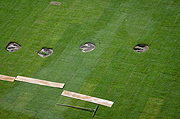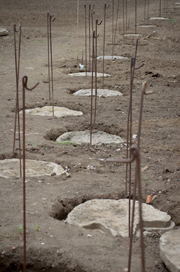Museum's dinosaur footprints return for ‘second run’

Casts of footprints laid down by a Megalosaurus dinosaur in Oxfordshire over 160 million years ago have been reinstalled outside the Museum of Natural History ahead of the Museum’s reopening next year. But rather than put the prints back in the same position as before, Museum staff have taken the opportunity to update the trackways by using current scientific ideas about the way the dinosaur moved.
The prints are casts taken from a fossilised trackway discovered at Ardley Quarry near Bicester in 1997. It is thought that they were made by the large, three-toed carnivore Megalosaurus bucklandii, which roamed the lagoons of Jurassic Oxfordshire some 166-168 million years ago.
Before landscaping work commenced outside the Museum this year, the prints were roughly evenly spaced across the lawn, showing the dinosaur’s walking pattern. But the actual trackways found in the quarry showed changes in the spacing and depth of the footprints, believed to be caused by changes in the dinosaur’s gait as it broke from a walk into a run, perhaps chasing prey.

For the past few weeks, Juliet Hay, preparator and conservator for the Museum’s Earth Collections, has carefully measured and arranged the casts by plotting out a ‘walking phase’, with a short stride length, and adding a ‘running phase’ based on research in an article published in the journal Nature.
Although the walking and running phases are actually separated at the quarry, GPS data have revealed that they are very likely to have been a continuous trackway, made by the same dinosaur. However, as the Museum only has a certain number of casts, and the layout also needed to consider the lawn’s sprinkler system, the new trackway is an illustration of the dinosaur’s movements rather than an exact replica.
In the new formation the Megalosaurus footprints show the dinosaur walking at around 4.23mph, breaking into a run reaching 18.14mph, then slowing back down to a walk at the end of its journey, on the south side of the lawn.
“From five year olds skipping along them, making giant steps and roaring, to secondary students honing their maths skills to determine the dinosaur’s size and speed, the footprints are a favourite discovery for staff and visitors alike,” says Chris Jarvis, Education Officer.
The Megalosaurus is a very special dinosaur for Oxford. It is the very first dinosaur to be scientifically described, based on fossils found in a quarry in Stonesfield, a small village just outside Oxford. It was named Megalosaurus, which translates as ‘great lizard’, in 1824 by William Buckland, the Museum’s first Reader in Geology. The 19th-century finds in the Stonesfield quarry include the famous Megalosaurus jaw which is now held in the Museum’s collection.
Press Release: 16 September 2013
Enquiries regarding events at the Museum should be sent to: info@oum.ox.ac.uk
